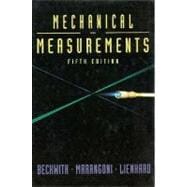
| Fundamentals of mechanical measurement | |
| The Process of Measurement: An Overview | |
| The significance of mechanical measurement | |
| Fundamental methods of measurement | |
| The generalized measuring system | |
| Types of input quantities | |
| Measurement standards | |
| Calibration | |
| Uncertainty: accuracy of results | |
| Reporting results | |
| Standards and Dimensional Units of Measurement | |
| Establishment of dimensional standards | |
| Historical background of measurement standards in the United States | |
| The SI system | |
| The standard of length | |
| The standard of mass | |
| Time and frequency standards | |
| Temperature standards | |
| Electrical standards | |
| Conversion between systems of units | |
| Significant digits, rounding, and truncation | |
| Assessing and Presenting | |
| Experimental Data.Common types of error | |
| Introduction to uncertainty | |
| Estimation of precision uncertainty | |
| Theory based on the population | |
| Theory based on the sample | |
| Goodness of fit | |
| Statistical analysis by computer | |
| Bias and single-sample uncertainty | |
| Propagation of uncertainty | |
| Examples of uncertainty analysis | |
| Minimizing error in designing experiments | |
| The Chi-Squared (x2) distribution | |
| Graphical presentation of data | |
| Line fitting and the method of least squares | |
| The Analog Measurand: Time-Dependent Characteristics | |
| Simple harmonic relations | |
| Circular and cyclic frequency | |
| Complex relations | |
| Frequency spectrum | |
| Harmonic, or Fourier, Analysis | |
| Amplitudes of waveforms | |
| The Response of Measuring Systems | |
| Amplitude response | |
| Frequency response | |
| Phase response | |
| Predicting performance for complex waveforms | |
| Delay, rise time, and slew rate | |
| Response of experimental system elements | |
| Simplified physical systems | |
| Mechanical elements | |
| An example of a simple mechanical system | |
| The importance of damping | |
| Dynamic characteristics of simplified mechanical systems | |
| Single-degree-of-freedom spring-mass damper systems | |
| The zero-order system | |
| Characteristics of first-order systems | |
| Characteristics of second-order systems | |
| Electrical elements | |
| First-order electrical system | |
| Simple second-order electrical system | |
| Calibration of system response | |
| Sensors.Loading of the signal source | |
| The secondary transducer | |
| Classification of first-stage devices | |
| Variable-resistance transducer elements | |
| Sliding-contact devices | |
| The resistance strain gage | |
| Thermistors | |
| The termocouple | |
| Variable-inductance transducer elements | |
| The differential transformer | |
| Variable-reluctance transducers | |
| Capacitive transducers | |
| Piezoelectric sensors | |
| Semiconductor sensors | |
| Light-detecting transducers | |
| Hall-effect sensors | |
| Some design-related problems | |
| Signal Conditioning | |
| Advantages of electrical signal conditioning | |
| Modulated and unmodulated signals | |
| Input circuitry | |
| The simple current-sensitive circuit | |
| The ballast circuit | |
| Voltage-dividing circuits | |
| Small changes in transducer resistance | |
| Resistance bridges | |
| Reactance or impedance bridges | |
| Resonant circuits | |
| Electronic amplification or gain | |
| Electronic amplifiers | |
| Vacuum-tube amplifiers | |
| Solid-state amplifiers | |
| Integrated circuits | |
| Operational amplifiers | |
| Special amplifier circuits | |
| Shielding and grounding | |
| Filters | |
| Some filter theory | |
| Active filters | |
| Differentiators and integrators | |
| Component coupling methods | |
| Digital Techniques in Mechanical Measurements | |
| Why use digital methods? Digitizing mechanical inputs | |
| Fundamental digital circuit elements | |
| Number systems | |
| Binary codes | |
| Some simple digital circuitry | |
| The digital computer as a measurement system tool | |
| Data processors, computers, microcomputers: the computer hierarchy | |
| The microprocessor | |
| The microcomputer | |
| Analog-to-digital and digital-to-analog conversion | |
| Buses | |
| Getting it all together.9 | |
| Readout and Data Processing.The electronic counter | |
| Analog electric meter indicators | |
| Meters with electronic amplification | |
| Digital-readout multimeters | |
| The cathode-ray os | |
| Table of Contents provided by Publisher. All Rights Reserved. |
The New copy of this book will include any supplemental materials advertised. Please check the title of the book to determine if it should include any access cards, study guides, lab manuals, CDs, etc.
The Used, Rental and eBook copies of this book are not guaranteed to include any supplemental materials. Typically, only the book itself is included. This is true even if the title states it includes any access cards, study guides, lab manuals, CDs, etc.